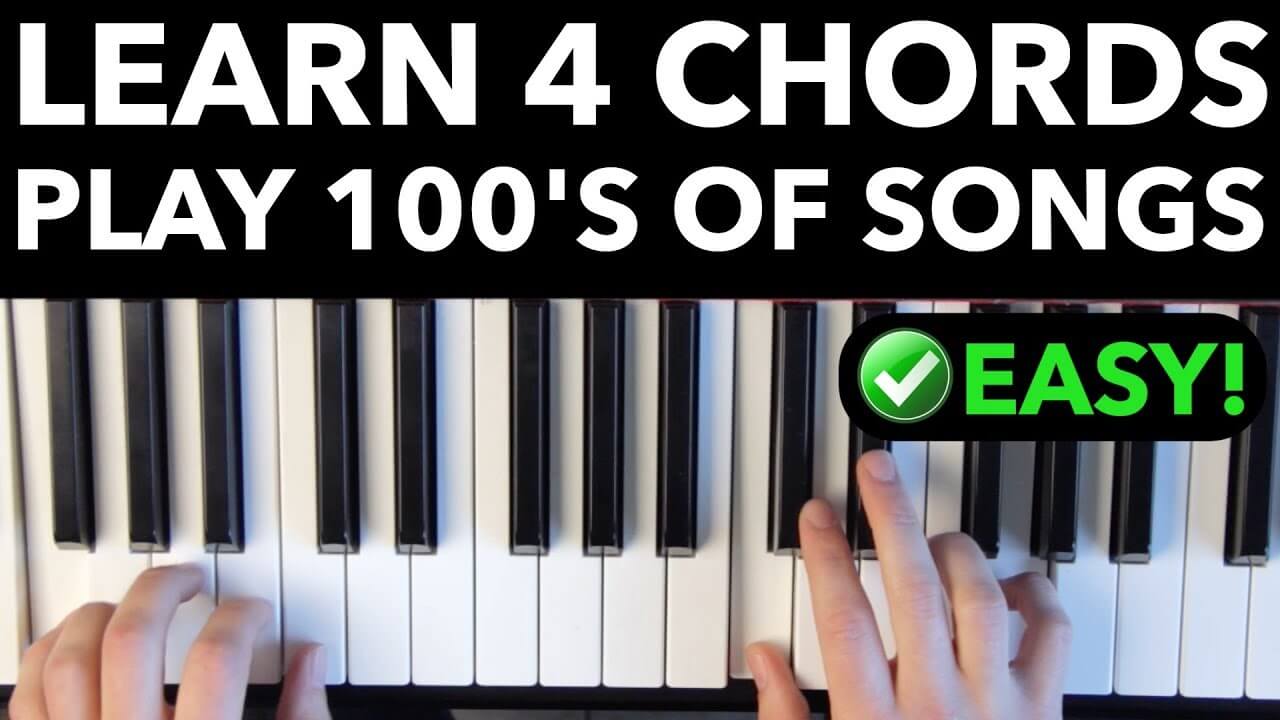Today you’re going to learn 4 simple chords you can use to play hundreds of famous songs on piano and at the same time work on your improv skills.
This lesson is going to be the super easy beginner’s piano lesson. I don’t care if you’ve never touched a piano in your life – you can learn this in less than a week. Most beginners take as little as 3 days to learn this.
This blog post is going to be three parts.
First, I’m going to show you the exact notes of the chords.
Step two I’m going to show you how to drill them into your system so they’re rock solid in your muscle memory and you’re not going to have problems getting hands together coordination and sloppy playing.
The third section you’re going to learn how to use money patterns which is basically simple variations you can use that really adds spice, life, and pop too.
Here’s what the 4 chord progression is going to sound like. Remember, if it seems complicated, if it looks difficult, I guarantee you can learn it and you’ll see how easy it is once we break it down step-by-step.
In the video I shared above you’ll see that we could use the same 4 chords in a different pattern to get a different sound.
Okay, let’s get started on actually learning how to play this.
To learn these chords we’re basically going to use a couple of music theory hacks to make it even easier.
Before writing this post, I looked up A LOT of videos around this topic to make sure my method was the easiest, and these other videos would say their method was easy, but then they’d be playing these big 4-note chords moving their hands all over the piano. That’s way too difficult for beginners!
I’m not going to do that to you. Let’s make things super simple. Sound good? Cool.
Part 1: The Notes
Alright, here’s the 4 chords. The first thing you’re going to do is put both of your thumbs on C. You’ll find two black notes, go one note below it, that’s a C. Do this for your right thumb, then find the next set of two black notes to the left and go one note below – that’s C for your left hand.
Your thumbs are going to stay on C throughout this entire lesson and your fingers are going to stay on the corresponding notes as well. You never have to shift your hands or move your fingers – they’ll stay on the exact same notes.
The Chords
Your first chord is a C Major and you’re going to play a C in your left hand and C-E-G in your right hand.
Next is a G Major chord. You’ll play a B in your left hand and C-D-G in your right hand. Now, technically this a G Sus chord in first inversion. I don’t want you to memorize that or even think about it if you’re a beginner. To simplify it, we’re just going to call this a G chord.
Our next chord is A Minor. We have an A with your left hand and C-E-G in your right hand. Again, this is technically an A Minor 7th chord, but we’re going to keep things simple again and call it an A Minor chord.
F Major is our fourth chord. For this we have an F with our left hand and C-F-G with our right hand. This chord is actually called F Major Add9. We’re calling this an F chord to make things simple once more.
Now we have our 4 chords – C G Am F. Before you think “Hey, I have the chords now, I’m going to rush off to my piano and play it” I want you to know that a lot of people don’t learn this the right way. What ends up happening is you get sloppy and playing hands together becomes a challenge.
How to Drill These Chords Super Deep in your Muscle Memory
We’ll start with the left hand, which is a lot easier than the right hand because you’re only playing one note at a time vs. the three notes at a time you play with the right hand. Our goal is to get our left hand so rock-solid that you could get it in your sleep. How are we going to do that? By using “The 4 Rhythms,” which is a common strategy used in piano to drill in muscle memory.
Here’s how this strategy works. The four notes of the left hand are C-B-A-F. You’ll repeat these four notes four times.
The next step involves us running that sequence four times using the first rhythm which is: Long, Short Long, Short. You’ll repeat this four times. If you’re confused, take a look at this video for a demonstration.
Our second rhythm is: Short Long, Short Long. This rhythm is the reverse of the one we just did. Before we go into rhythm number three, I just want to let you know that I have a PDF cheat sheet with these rhythms as well. This is part of my free “Become a Piano Superhuman” course. When you sign up for free you just have to scroll all the way to the bottom to the section called “Extras” and you’ll see the PDFs.
Next, we have our third rhythm: Long, Short Short Short Long, Short Short Short. We’ll repeat this rhythm four times as well.
The final rhythm is just the opposite of our third rhythm so it’s: Short Short Short Long, Short Short Short Long. Repeat that four times.
Our last step is to play these chords normally four times without using any of the rhythms. It’s important that you don’t skip this step. I hope you can see why learning it like this is really going to drill this into your muscle memory.
The Right Hand
Moving on to the next step we’re going to start adding in our right hand, which has four chords. You’ll notice that the outside of the chord stays the same. You have your 1 and your 5 on the C and the G and every chord has these notes. You’re always playing the C and G, just adjusting which notes you’re playing in between.
What I want you to do now is just play the outside notes, C and G, with your right hand, while you play the other notes for your left hand. If you’re having trouble getting hands together, what I want you to do is two things. First, slow down. Second, I want you to stare at your left hand while you’re playing it.
Once you have this all rock-solid you could literally stop here. That already sounds cool! Watch the video to hear what I mean.
But guess what? You’re not going to do that! Why? Because you want to get to the next level of piano. I’ll explain how.
We’re going to add in the middle notes to take this pattern to the next level. For this pattern we’ll start with E down to D back up to E and then up to F. You just repeat these four notes over and over again.
What I want you to do with these four notes is practice them in the four rhythms I mentioned before.
Once we have these drilled in, we’re going to add the outside notes with the middle notes. This is when people start freaking out because at this point you’ll be playing three notes at one time. However, when you think about it, you’ve already learned C and G, which stay the same, and you know the middle notes – we’re just putting it all together now.
Though it may seem overwhelming at this point, just remember, this is the point at which you really learn – when you’re actually challenged. Stick with it and push through! It’ll all be worth it once you come out the other side.
To simplify it at the beginning, I want you to do two chord alternates. We’ll take our first chord, C-E-G, and then our next chord, C-D-G. The only thing that changes is your middle finger playing the E to your pointer finger playing a D. All you have to do is to alternate between these two chords and drill it till the cows come home!
The next step is taking the last two chords and alternate. We’ll play C-E-G, then C-F-G. Again, I want you to play this over and over until you can play it in your sleep!
Once you have that rock-solid, we’re going to play all four chords. I want you to play these four chords over and over to drill them into your muscle memory. Then, when we add our left hand it’ll be much easier to get everything together.
Playing Hands Together (The Final Step)
A hands together demonstration can be seen here. We’re going to learn hands together the same way we learned the middle notes of our right hand, taking two chords at a time, alternating between them.
The first two chords are C Major (C with our left hand and C-E-G with our right hand) and G Major (B with our left hand and C-D-G with our right hand). If this is already too tricky for you, what I want you to do is sleep on it. If you’re a complete beginner, a lot of times this is the point in the lesson when you can’t get it, even if you’re practicing a lot. The reason is, when you sleep on it, it consolidates all your muscle memory and learning.
Once you’ve alternated the first two chords, we’re then going to take the G chord down to an A Minor (A with your left hand and C-E-G with your right hand). It can be a little tricky for people because we’re moving in opposite directions with our left and right hands. Repeat this over and over, alternating these chords.
The next step is taking the next two chords, the A Minor chord moving to our F chord (F with our left hand and C-F-G with our right hand). Repeat this to drill it down into your muscle memory.
Taking all four chords is next. Hopefully you understand the benefits of doing two chords at a time and drilling them in first. We’ll repeat all four chords over and over until we have them drilled into our muscle memory. Once you have all four chords, congrats! You now have the basic structure of the chord progression.
To really make this pop, we’ll go through “Money patterns and variations.” For this, we’re using the same notes, but just changing the rhythms of it and how we play the notes. Watch this for some really cool examples. These extras can be found in the same place as the PDFs I mentioned. Check them out here scrolling to the bottom after you sign up.

